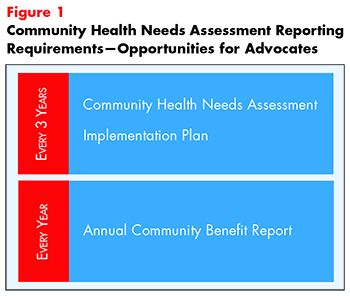Community Health Needs Assessment: A Brief Background
The Affordable Care Act (ACA) introduced new requirements for nonprofit hospitals to demonstrate community benefit, chief among them the Community Health Needs Assessment (CHNA).1 The CHNA is meant to broaden a hospital’s focus to include the health issues in the greater community. The CHNA reporting process creates new ways for advocates, community organizations and others to interact with large hospitals, influence what community health issues will be addressed and ensure that hospitals are living up to their mission, vision and values.
The New 501c(3) Hospital
There are many benefits for organizations that gain 501c(3) nonprofit status, including significant tax breaks. These tax benefits include both income tax and property tax breaks that can save a hospital millions of dollars each year. Additionally, there is often a more favorable public perception around hospitals that operate as a nonprofit compared to those operating under for-profit status.
To achieve this nonprofit status and its benefits, hospitals need to demonstrate that they provide a sufficient level of community benefit to justify the reduction in tax revenue. Prior to passage of the ACA this benefit came primarily from providing charity care to uninsured patients or others who did not have the ability to pay for the care they received. Due to the reduction in the number of individuals who are uninsured,2 the IRS, as directed by the ACA, implemented CHNA to broaden hospitals’ focus to providing sufficient and impactful community benefits.
What is a Community Health Needs Assessment?
The Community Health Needs Assessment is a report that focuses not only on the healthcare needs (diabetes care, heart disease) of the local population, but the community’s overarching health needs (e.g., food, housing, etc.).3 The purpose is to ensure that hospitals have the information they need to provide community benefits that meet the needs of their communities and fulfill IRS requirements. Hospitals are also required to develop an implementation strategy to meet the identified community health needs, but how far the organization’s obligation extends is a matter of debate.
Hospitals are required to produce a comprehensive CHNA every three years. They are also required to produce an annual community benefit report detailing the level of community benefit provided per the implementation strategy (see Figure 1).4
The CHNA requires hospitals to take a more active role in the overall health of their community.5 The CHNA shines a spotlight on socioeconomic factors and how they should be addressed to improve the health of the community.

Keeping Hospitals Accountable—Opportunities for Advocates
In addition to reporting these documents to the IRS, hospitals are required to make their CHNA available to the public. A majority of hospitals post their full CHNA on their websites. This public reporting requirement does not extend to the implementation plan or the annual community benefit report, however.
What’s more, by statute, the CHNAs must take into account input from “persons who represent the broad interests of the community served by the hospital facility, including those with special knowledge of or expertise in public health.”6
Together, these aspects of the CHNA mean that community members, community organizations, community advocates and public health organizations have an opportunity to engage with hospital leadership and influence the direction the hospital takes in addressing community health needs. For example, CNHA does not include an explicit requirement to measure and address health disparities. Advocacy groups could assist hospitals in addressing this area to better meet the needs of the community.
Conclusion
The introduction of the CHNA requirements broadens the institution’s focus to the health issues in the greater community.
While not yet a widespread practice, the CHNA provides substantial opportunity for advocates and hospitals to work together to better address community health needs.
Advocates, community organizations and others can interact with hospitals, influence the community health issues to be addressed and ensure that hospitals are living up to their mission, vision and values. Going forward, taking significant input from community members and community partners will have the potential to produce more impactful results from the CHNA process.7
Notes
1.Other nonprofit requirements introduced by the ACA include: Adopt a written financial assistance policy that includes eligibility criteria, methods used to calculate charges, applications for assistance, and actions associated with billing and collections. Limit charges for services to levels equivalent to amounts generally billed for insured patients. Make reasonable efforts to determine an individual’s eligibility for financial assistance prior to extraordinary measures to secure payment.
2.Due to the Affordable Care Act (ACA) the uninsurance rate fell below 10% in 2015. This drop in the uninsurance rate is a large step forward in ensuring that all citizens have access to healthcare. See: Diamond, Dan, “Thanks, Obamacare: America’s Uninsured Rate Is Below 10% For First Time Ever,” Forbes (Aug. 12, 2015).
3.Rosenbaum, Sara, “Additional Requirements for Charitable Hospitals: Final Rules on Community Health Needs Assessments and Financial Assistance,” Health Affairs Blog (Jan. 23, 2015).
4.U.S. National Library of Medicine, Community Benefit/Community Health Needs Assessment, https://www.nlm.nih.gov/hsrinfo/community_benefit.html (accessed on Mar. 25, 2016).
5.Barnett, Kevin, Best Practices for Community Health Needs Assessment and Implementation Strategy Development: A Review of Scientific Methods, Current Practices, and Future Potential, Public Health Institute, Washington, D.C. (February 2012).
6.Ibid.
7.Ibid.







